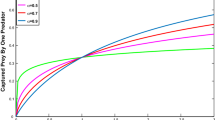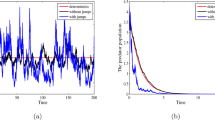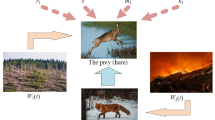Abstract
A three-species ecological model is proposed that comprises one prey and two predators (low predator and top predator) to understand the persistence and/or extinction of prey and predators under a suitable environment. The realistic ecological system is typically inhomogeneous in terms of spatiotemporal variations of population density. With this motivation, white noise is introduced to the system to conceive the impact of environmental heterogeneity on the interaction of prey and predators. The boundedness of solutions of the system is presented. The condition for the local stability of the deterministic model is established. The stochastic analysis of the system suggests the impression of the environmental noise on the dynamical behaviour of solutions. Numerical results reveal that the proposed system exhibits an oscillatory pattern of solutions. It is shown that the white noise in the low predator has a dominating role in comparison with other noises to keep the oscillation in order. Moreover, to investigate the spatial dependency of the population density, diffusion term is introduced to the system that also displays oscillatory behaviour of the solutions. The results also confirm that the population density of prey, low predator, and top predator have a biological control in the oscillatory behaviour. In the presence of diffusion and white noise, numerical simulation illustrates the sensitivity of the diffusion coefficients and the amplitude of noises. Numerical results lead to a reasonable agreement with the analytical findings in both non-spatial and spatial systems.



















Similar content being viewed by others
References
Abid W, Yafia R, Aziz Alaoui M, Bouhafa H, Abichou A (2015) Instability and pattern formation in three-species food chain model via holling type II functional response on a circular domain. Int J Bifurc Chaos 25(06):1550092
Agiza HN et al (2009) Chaotic dynamics of a discrete prey predator model with holling type ii. Nonlinear Anal Real World Appl 10:116–129
Anita L, Anita S, Arnautu V (2009) Optimal harvesting for periodic age-dependent population dynamics with logistic term. Appl Math Comput 215:2701–2715
Banerjee M, Volpert V (2017) Spatio-temporal pattern formation in Rosenzweig–Macarthur model: effect of nonlocal interactions. Ecol Complex 30:2–10
Banerjee M, Mukherjee N, Volpert V (2018) Prey–predator model with a nonlocal bistable dynamics of prey. Mathematics 6(3):41
Bera SP, Maiti A, Samanta GP (2016) Dynamics of a food chain model with herd behaviour of the prey. Model Earth Syst Environ 2(3):131
Carletti M (2006a) Numerical simulation of a campbell-like stochastic delay model for bacteriophage infection. Math Med Biol (An IMA Journal) 23:297–310
Carletti M (2006b) Numerical solution of stochastic differential problems in the biosciences. J Comput Appl Math 185:422–440
Chen F, Ma Z, Zhang H (2012) Global asymptotical stability of the positive equilibrium of the lotka–volterra prey–predator model incorporating a constant number of prey refuges. Nonlinear Anal Real World Appl 13:2790–2793
Choi YH, Baek H (2016) Dynamical behaviors of a discrete predator–prey system with beddington-deangelis functional response. Kyungpook Math J 56(1):47–55
Colinvaux P (1986) Ecology. Wiley, New York
Danca M, Codreanu S, Bako B (1997) Detailed analysis of a nonlinear prey–predator model. J Biol Phys 23(1):11
Das K, Reddy KS, Srinivas M, Gazi N (2014) Chaotic dynamics of a three species prey–predator competition model with noise in ecology. Appl Math Comput 231:117–133
Dubey B, Das B, Hussain J (2001) A predator–prey interaction model with self and cross-diffusion. Ecol Model 141(1–3):67–76
Duncan S et al (2011) Optimal harvesting of fish stocks under a time-varying discount rate. J Theor Biol 269:166–173
Elsadany AA (2012) Dynamical complexities in a discrete-time food chain. Comput Ecol Softw 2(2):124–139
Freedman HI (1980) Deterministic mathematical models in population ecology. Marces-Decker, New York
Freedman HI, Waltman P (1984) Persistence in models of three interacting predator–prey populations. Math Biosci 68(2):213–231
Gani MO, Ogawa T (2015) Instability of periodic traveling wave solutions in a modified fitzhugh–nagumo model for excitable media. Appl Math Comput 256:968–984
Gard TC (1982) Top predator persistence in differential equation models of food chains: the effects of omnivory and external forcing of lower trophic levels. J Math Biol 14:285–299
Garvie MR (2007) Finite-difference schemes for reaction–diffusion equations modeling predator–prey interactions in M ATLAB. Bull Math Biol 69(3):931–956
Gopalsamy K (1992) Stability and oscillations in delay differential equations of population dynamics. Kluwer Academic, New York
Gupta RP, Chandra P (2013) Bifurcation analysis of modified leslie–gower predator–prey model with michaelis–menten type prey harvesting. J Math Anal Appl 338:278–295
Hastings A, Powell T (1991) Chaos in a three-species food chain. Ecology 72(3):896–903
Heck KL Jr, Thoman TA (1981) Experiments on predator–prey interactions in vegetated aquatic habitats. J Exp Mar Biol Ecol 53(2–3):125–134
Holling CS (1973) Resilience and stability of ecological systems. Ann Rev Ecol Syst 4:1–23
Hurwitz A et al (1964) On the conditions under which an equation has only roots with negative real parts. Sel Papers Math Trends Control Theory 65:273–284
Juarlin E (2019) Solution of simple Prey–Predator model by Runge–Kutta method. J Phys Conf Ser 1341(6):062024
Kapur JN (1985) Mathematical models in biology and medicine. Affiliated East–West
Kawasaki K, Teramoto E (1979) Spatial pattern formation of prey–predator populations. J Math Biol 8(1):33–46
Keshet LE (2005) Mathematical models in biology. SIAM, Bangkok
Lotka AJ (1925) Elements of physical biology. Williams and Wilkins, Philadelphia
Maiti A, Samanta G (2005) Deterministic and stochastic analysis of a prey-dependent predator–prey system. Int J Math Educ Sci Technol 36(1):65–83
Maiti A, Jana M, Samanta G (2007) Deterministic and stochastic analysis of a ratio-dependent predator–prey system with delay. Nonlinear Anal Model Control 12(3):383–398
Maiti A, Sen P, Samanta G (2016) Deterministic and stochastic analysis of a prey–predator model with herd behaviour in both. Syst Sci Control Eng 4(1):259–269
Manna K, Volpert V, Banerjee M (2020) Dynamics of a diffusive two-prey-one-predator model with nonlocal intra-specific competition for both the prey species. Mathematics 8(1):101
Meyer WJ (1985) Concepts of mathematical modelling. McGraw-Hill, New York
Mukherjee D, Guin LN, Chakravarty S (2019) A reaction–diffusion mathematical model on mild atherosclerosis. Model Earth Syst Environ 5(4):1853–1865
Murray JD (2007) Mathematical biology I: an introduction. Springer Science and Business Media, Berlin
Naji RK, Badai AJ (2011) A three species ratio-dependent food web model dynamics. J Basrah Res (Sciences) 37(4):1–11
Naji RK, Balasim AT (2007) Dynamical behavior of a three species food chain model with beddington-deangelis functional response. Chaos Solitons Fractals 32(5):1853–1866
Nisbet RM, Gurney WSC (1982) Modelling fluctuating populations. Wiley, New York
Pal D, Mahapatra GS, Samanta GP (2012) A proportional harvesting dynamical model with fuzzy intrinsic growth rate and harvesting quantity. Pac Asian J Math 6:199–213
Pal S, Banerjee M, Ghorai S (2019) Spatio-temporal pattern formation in holling-tanner type model with nonlocal consumption of resources. Int J Bifurc Chaos 29(01):1930002
Palma A, Olivares E (2012) Optimal harvesting in a predator–prey model with allee effect and sigmoid functional response. Appl Math Comput 36:1864–1874
Peet AB, Deutsch PA, Lopez EP (2005) Complex dynamics in a three-level trophic system with intraspecies interaction. J Theor Biol 232:491–503
Pielou EC (1974) Population and community ecology: principles and methods. CRC Press, Boca Raton
Pielou EC et al (1969) An introduction to mathematical ecology. Wiley, New York
Ripa J, Lundberg P (1996) Noise colour and the risk of population extinction. Proc R Soc Lond B 263:1751–1753
Roughgarden J (1976) Resource partitioning among competing species—a coevolutionary approach. Theor Popul Biol 9(3):388–424
Routh EJ (1877) A treatise on the stability of a given state of motion: particularly steady motion. Macmillan and Company, London
Sagayaraj MR et al (2013) Dynamical behavior in a three species discrete model of prey–predator interactions. Int J Comput Sci Math 5(1):11–20
Sahoo B, Das B, Samanta S (2016) Dynamics of harvested-predator–prey model: role of alternative resources. Model Earth Syst Environ 2(3):140
Samanta S, Sahoo B, Das B (2020) Emergent impacts of alternative resource in cannibalistic predator–prey system. Model Earth Syst Environ. https://doi.org/10.1007/s40808-020-00884-w
Sen D, Ghorai S, Banerjee M (2018) Complex dynamics of a three species prey–predator model with intraguild predation. Ecol Complex 34:9–22
She J (2016) Canard limit cycles and global dynamics in a singularly perturbed predator–prey system with non-monotonic functional response. Nonlinear Anal Real World Appl 31:146–165
Shome P, Maiti A, Poria S (2016) Effects of intraspecific competition of prey in the dynamics of a food chain model. Model Earth Syst Environ 2(4):1–11
Simmons GF (1974) Differential equations with applications and historical notes. Tata McGraw-Hill, New Delhi
Srinivas NC (1991) Some mathematical aspects of modeling in bio medical sciences. Ph.D. thesis, Kakatiya University
Sun GQ, Jin Z, Li L, Liu QX (2009) The role of noise in a predator–prey model with allee effect. J Biol Phys 35(2):185–196
Upadhyay RK, Patra A, Dubey B, Thakur N (2014) A predator–prey interaction model with self-and cross-diffusion in aquatic systems. J Biol Syst 22(04):691–712
Vilar JM, Solé RV (1998) Effects of noise in symmetric two-species competition. Phys Rev Lett 80(18):4099
Volterra V (1931) Leçonssur la théoriemathématique de la lutte pour la vie. Gauthier-Villars, Paris
Wang W et al (2011) The effect of colored noise on spatiotemporal dynamics of biological invasion in a diffusive predator–prey system. Biol Syst 104:48–56
Xiao D, Ruan S (2016) Global analysis in a predator–prey system with nonmonotonic functional response. SIAM J Appl Math 61(4):1445–1472
Xu C, Li Z (2003) Population dynamics and the color of environmental noise: a study on a three-species food chain system, ecol. res. 18, 2003, 145–154. mics and the color of environmental noise: a study on a three-species food chain system. Ecol Res 18:145–154
Acknowledgement
The authors are sincerely thankful to the anonymous referees for their insightful comments that helped to enhance the quality of the article.
Author information
Authors and Affiliations
Corresponding author
Additional information
Publisher's Note
Springer Nature remains neutral with regard to jurisdictional claims in published maps and institutional affiliations.
Rights and permissions
About this article
Cite this article
Das, K., Srinivash, M.N., Kabir, M.H. et al. Noise-induced control of environmental fluctuations in a three-species predator–prey model. Model. Earth Syst. Environ. 7, 2675–2695 (2021). https://doi.org/10.1007/s40808-020-01051-x
Received:
Accepted:
Published:
Issue Date:
DOI: https://doi.org/10.1007/s40808-020-01051-x




